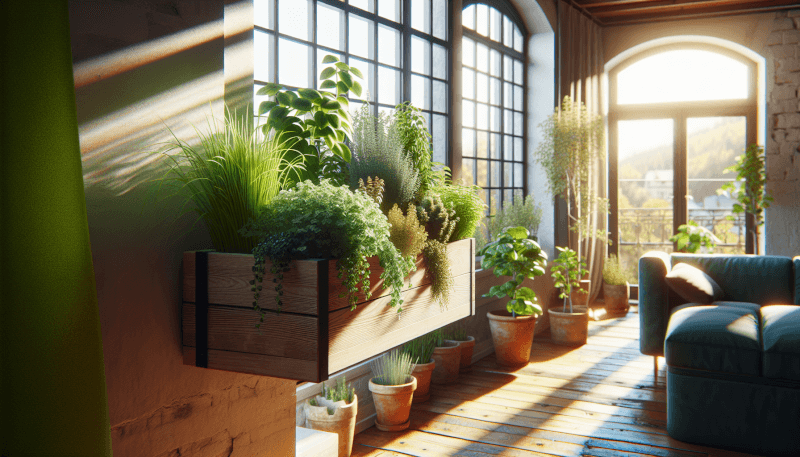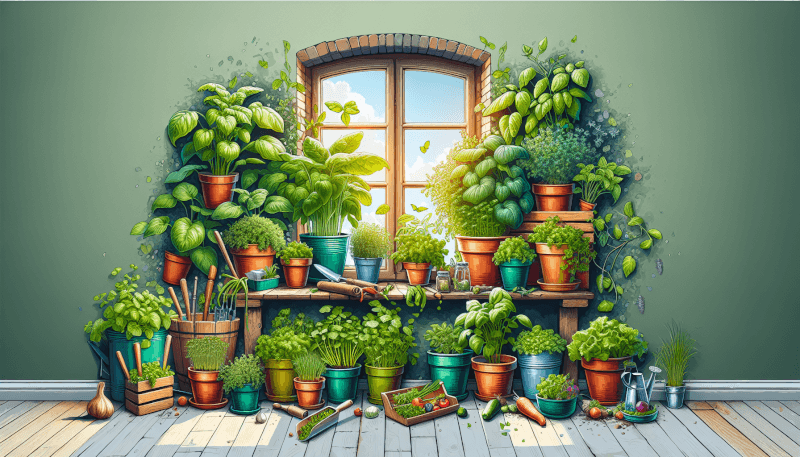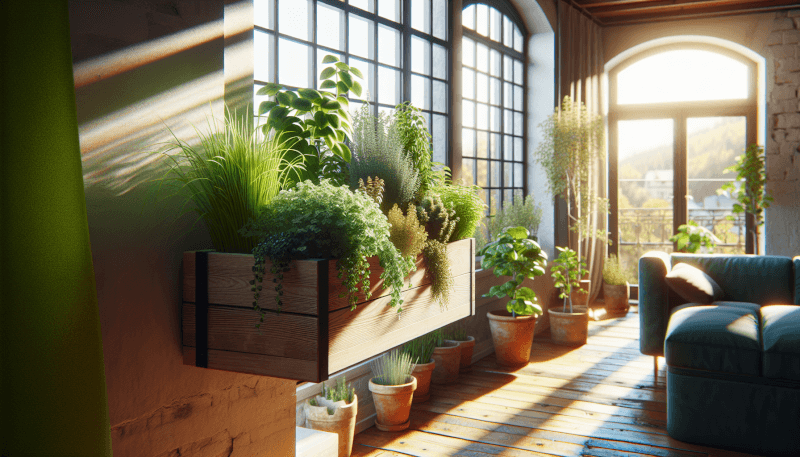Are you a city dweller with a green thumb and a small living space? Look no further than indoor apartment vegetable gardening! In this article, we will explore the joys and benefits of cultivating your own vegetables right inside your cozy apartment. From herbs to leafy greens, there are a variety of plants that thrive indoors and can provide you with fresh, homegrown produce all year round. Whether you have a sunny windowsill or a designated growing area, we will share tips and techniques to help you get started on your urban gardening journey. Get ready to bring the beauty and bounty of nature into your apartment and enjoy the satisfaction of harvesting and eating your very own vegetables!

Choosing the Right Vegetables
When it comes to indoor apartment vegetable gardening, it’s important to choose the right vegetables that are suitable for growing indoors. Considering the space limitations of an apartment, you need to select vegetables that do well in containers and don’t require a lot of space to grow. Some great options include herbs like basil, parsley, and cilantro, leafy greens like lettuce and spinach, and compact varieties of vegetables like cherry tomatoes and peppers.
Considering Space Limitations
One of the key factors to keep in mind when choosing vegetables for indoor gardening is the space limitations of your apartment. Most apartments have limited space, so it’s crucial to pick vegetables that can thrive in containers and don’t require extensive room to grow. Look for compact varieties that are specifically bred for small spaces, such as dwarf tomatoes or mini bell peppers. These will take up less space while still providing you with a bountiful harvest.
Selecting Vegetables Suitable for Indoor Gardening
In addition to considering space limitations, it’s important to choose vegetables that are suitable for growing indoors. Some vegetables are better suited for indoor gardening than others due to their growth habits and adaptability to indoor conditions. Leafy greens like lettuce and spinach, as well as herbs like basil and parsley, are excellent choices for indoor gardening. These vegetables are relatively easy to grow and don’t require a lot of sunlight or space.
Determining the Right Container Size and Type
Once you have selected the vegetables you want to grow, it’s time to determine the right container size and type. The size of the container will depend on the mature size of the vegetable you are growing. Smaller vegetables like lettuce and herbs can be grown in small pots or even in a hanging basket. On the other hand, larger vegetables like tomatoes or peppers will require larger containers to accommodate their root system.
When it comes to container type, there are a few options to choose from. Terra cotta pots are a popular choice as they are porous and allow for better drainage. Plastic pots are lightweight and easy to move around, while fabric pots provide excellent aeration for the roots. Whichever type you choose, make sure the container has drainage holes at the bottom to prevent waterlogging and root rot.
Setting Up Your Indoor Garden
Now that you have chosen your vegetables and containers, it’s time to set up your indoor garden. There are a few key factors to consider to ensure your plants thrive in their new environment.
Choosing a Dedicated Space
First, choose a dedicated space in your apartment for your indoor garden. It should be an area that receives adequate sunlight or has access to grow lights if natural light is limited. Consider setting up your indoor garden near a window that gets southern or western exposure, as these directions tend to receive the most sunlight throughout the day.
Ensuring Proper Lighting
Light plays a crucial role in the growth and development of plants, so it’s important to ensure your indoor garden receives adequate lighting. If your chosen space doesn’t receive enough natural light, you can supplement it with artificial grow lights. LED grow lights are a popular choice for indoor gardening, as they are energy-efficient, emit the right spectrum of light for plant growth, and produce less heat.
Providing Adequate Ventilation
Good air circulation is essential for preventing the build-up of moisture and controlling the temperature in your indoor garden. If your indoor garden is in a small, enclosed space, consider using a fan or opening windows periodically to promote air movement. This will help prevent fungal diseases and ensure a healthy growing environment for your vegetables.
Maintaining the Right Temperature and Humidity Levels
Different vegetables have different temperature and humidity requirements, so it’s important to maintain the right conditions for your indoor garden. Most vegetables thrive in temperatures between 65°F to 75°F (18°C to 24°C) during the day and slightly cooler temperatures at night. Keep an eye on the humidity levels as well, as some vegetables like higher humidity while others prefer drier conditions. Use a hygrometer to monitor the humidity in your indoor garden and make adjustments as needed.

Preparing the Soil
Before you start planting your vegetables, it’s crucial to prepare the soil to provide a nutrient-rich environment for their growth. Since indoor gardening often involves using containers, it’s best to use a potting mix specifically formulated for container gardening.
Selecting the Appropriate Potting Mix
When selecting a potting mix, look for one that is lightweight, well-draining, and rich in organic matter. Avoid using garden soil, as it can become compacted in containers and may contain pathogens that could harm your plants. The potting mix should also retain moisture without becoming waterlogged, as this can cause root rot. Look for potting mixes labeled specifically for vegetables or herbs for optimal results.
Adding Organic Matter for Nutrient-Rich Soil
To further enrich your potting mix, consider adding organic matter such as compost or well-rotted manure. Organic matter improves the soil structure, retains moisture, and provides essential nutrients to your plants. Mix in a small amount of organic matter into the potting mix before planting your vegetables to create a nutrient-rich growing medium.
Testing the Soil pH
Before planting your vegetables, it’s a good idea to test the pH of your soil. Different vegetables have different pH preferences, and maintaining the right pH level is crucial for nutrient uptake and overall plant health. Use a soil pH testing kit to determine the acidity or alkalinity of your soil. Most vegetables prefer a slightly acidic soil with a pH range of 6.0 to 7.0. If your soil’s pH is outside the ideal range, you can adjust it by adding amendments like lime to raise the pH or sulfur to lower it.
Starting from Seeds or Seedlings
Now that your indoor garden is all set up, it’s time to decide whether you want to start from seeds or purchase seedlings (young plants) to transplant into your containers.
Understanding Seed Germination Requirements
If you decide to start from seeds, it’s important to understand the germination requirements of the vegetables you are growing. Most vegetable seeds require a specific temperature range, moisture, and light conditions to successfully germinate. Follow the instructions on the seed packet or do some research to ensure you provide the optimal conditions for germination. Some seeds may require pre-soaking or scarification to break their dormancy and promote germination.
Providing Appropriate Seed Starting Containers
When starting seeds indoors, it’s essential to use appropriate seed starting containers. These containers should have good drainage to prevent waterlogging and allow air to reach the developing roots. You can use seed trays, peat pots, or even repurpose household items like egg cartons or yogurt cups. Just make sure to clean and disinfect any recycled containers before using them to prevent the spread of diseases.
Transplanting Seedlings into Larger Pots
If you decide to purchase seedlings instead of starting from seeds, you’ll need to transplant them into larger pots as they grow. This will give their roots more space to spread out and access the nutrients in the soil. Once the seedlings have developed a couple of sets of true leaves, carefully remove them from their nursery containers and transplant them into their permanent containers. Make sure to handle the delicate roots with care to avoid damaging them during the transplanting process.
Watering and Fertilizing
Proper watering and fertilizing are key to the success of your indoor vegetable garden. Here are some guidelines to follow:
Establishing a Watering Schedule
Establishing a regular watering schedule is crucial to maintain the right moisture levels in your containers. Most vegetables prefer evenly moist but not waterlogged soil. Check the moisture level of the soil by sticking your finger into the top inch of soil. If it feels dry, it’s time to water. Be mindful not to let the soil completely dry out, as this can stress the plants and hinder their growth. Water thoroughly until water drains from the bottom of the container, ensuring the entire root system is hydrated.
Avoiding Overwatering or Underwatering
Overwatering or underwatering can both lead to problems in your indoor vegetable garden. Overwatering can cause root rot and fungal diseases, while underwatering can stress the plants and cause stunted growth. Find the right balance by paying attention to the moisture level of the soil and adjusting your watering routine accordingly. Factors like temperature, humidity, and the size of the container will affect how often you need to water, so it’s important to monitor your plants’ needs consistently.
Selecting the Right Fertilizer for Vegetable Plants
Vegetable plants have specific nutrient requirements, and providing them with the right fertilizers is essential for their growth and productivity. Look for a balanced, water-soluble fertilizer formulated specifically for vegetables. These fertilizers contain a mix of nitrogen (N), phosphorus (P), and potassium (K), as well as other essential micro-nutrients. Follow the manufacturer’s instructions for application rates and frequency to avoid overfertilization.
Applying Fertilizers Effectively
To apply fertilizers effectively, dissolve the recommended amount in water according to the instructions on the fertilizer package. Water your plants with this solution, ensuring the whole root zone is evenly covered. Fertilize your indoor vegetable garden at regular intervals, usually every two to three weeks, to provide a steady supply of nutrients. Avoid overfertilizing, as this can lead to nutrient imbalances and damage your plants. Always follow the recommended application rates and adjust them based on the specific needs of your plants.
Pruning and Training Plants
Pruning and training your vegetable plants can help improve their growth and productivity. Here’s what you need to know:
Understanding the Importance of Pruning
Pruning involves removing certain parts of the plant, such as dead or diseased leaves, to promote healthy growth. It also helps shape the plant and control its size. Pruning allows for better air circulation and light penetration, reducing the chances of fungal diseases. Regularly inspect your indoor vegetable plants for any yellowing or diseased leaves and remove them promptly. Additionally, pruning can encourage the development of side shoots and increase overall yield.
Identifying the Appropriate Pruning Techniques for Vegetable Plants
Different vegetable plants have specific pruning needs, so it’s important to familiarize yourself with the appropriate pruning techniques for each plant. For example, indeterminate tomato plants benefit from removing the suckers (leafy growth between the stem and a branch) to redirect the plant’s energy towards the main stem and fruit production. Leafy greens like lettuce or spinach can be harvested by picking the outer leaves, which encourages the plant to produce new leaves.
Training Plants for Better Growth and Productivity
Training your vegetable plants involves guiding their growth in a specific manner to optimize space and sunlight exposure. You can accomplish this by using trellises, stakes, or cages to support climbing or vining plants, such as tomatoes or cucumbers. This not only helps keep the plants organized and prevents them from sprawling but also ensures better air circulation and easier harvesting. Regularly check on the plants’ growth and adjust the training structures as needed.
Managing Pests and Diseases
Indoor gardens are not immune to pests and diseases, but there are steps you can take to manage them naturally and prevent infestations:
Identifying Common Indoor Garden Pests
Some common pests that can affect indoor vegetable gardens include aphids, spider mites, whiteflies, and fungus gnats. Aphids are small, sap-sucking insects that can quickly multiply and damage plants. Spider mites are tiny arachnids that feed on plant sap, causing yellowing and stippling of leaves. Whiteflies are small, flying insects that also suck plant sap and can spread viruses. Fungus gnats are small flies that lay their eggs in moist soil and their larvae feed on plant roots.
Implementing Natural Pest Control Methods
When it comes to managing pests in your indoor garden, it’s best to opt for natural and organic methods. One effective method is handpicking pests off the plants and disposing of them. You can also use insecticidal soaps or horticultural oils to control soft-bodied pests like aphids or spider mites. Sticky traps can help catch flying insects like whiteflies. Additionally, introducing beneficial insects like ladybugs or lacewings can help control pest populations naturally.
Preventing Diseases Through Proper Plant Care
Preventing diseases in your indoor garden starts with proper plant care. Ensure good air circulation around your plants by providing adequate space between them. Avoid overcrowding, as it can create a favorable environment for the development and spread of fungal diseases. Water your plants at the base and avoid wetting the foliage, as damp leaves can lead to fungal infections. Regularly inspect your plants for any signs of diseases, such as spots, discoloration, or wilting, and take appropriate measures to address the issue promptly.
Harvesting and Using Your Homegrown Vegetables
One of the most rewarding aspects of indoor apartment vegetable gardening is being able to harvest and enjoy your homegrown vegetables. Here’s how to make the most of your harvest:
Knowing When to Harvest Vegetables
Each vegetable has its own harvesting time, so it’s important to know when your vegetables are ready to be harvested. Leafy greens like lettuce and spinach can be harvested when the outer leaves are large enough to harvest without damaging the plant. Tomatoes should be harvested when they are fully ripe in color but still firm to the touch. Peppers can be picked when they reach their desired size and color. Follow the specific guidelines for each vegetable to ensure optimal flavor and quality.
Properly Storing Harvested Vegetables
After harvesting your vegetables, it’s important to store them properly to prolong their freshness. Leafy greens can be stored in the refrigerator’s crisper drawer in a plastic bag with a damp paper towel to maintain moisture. Tomatoes should be stored at room temperature away from direct sunlight. Peppers can be stored in a cool, dry place. Avoid washing your vegetables until you are ready to use them, as moisture can promote spoilage.
Exploring Creative Recipes to Use Your Homegrown Produce
The best part of having homegrown vegetables is getting to enjoy them in delicious recipes. Experiment with different recipes that highlight the flavors of your vegetables. Create a refreshing salad with your freshly harvested lettuce and other vegetables. Make homemade basil pesto with your homegrown basil and serve it over pasta or spread it on bread. Use your tomatoes and peppers to make a flavorful salsa. The possibilities are endless, so get creative and savor the fruits of your indoor gardening labor.
Monitoring and Troubleshooting
Even with proper care, indoor vegetable gardening can sometimes present challenges. Regular monitoring and troubleshooting will help you address any issues that arise promptly.
Regularly Checking Plant Health
Regularly checking the health of your plants is crucial to catch any problems early on. Look out for signs of nutrient deficiencies, pest infestations, or diseases. Inspect the leaves for discoloration, wilting, spots, or any abnormalities. Check for pests and signs of their activity, such as chewed leaves or sticky residue. By catching issues early, you can take immediate action to prevent further damage.
Recognizing Signs of Nutrient Deficiencies
Nutrient deficiencies can manifest in different ways, depending on the specific nutrient that is lacking. Common signs include yellowing or browning leaves, stunted growth, and poor fruit production. For example, a nitrogen deficiency may cause pale green or yellowing leaves, while a potassium deficiency can result in yellowing or browning of leaf edges. Recognizing these signs will help you adjust your fertilization routine and provide the necessary nutrients to your plants.
Addressing Common Indoor Gardening Challenges
Indoor vegetable gardening can present its share of challenges, but with proper knowledge, you can overcome them. Some common challenges include low light levels, inadequate air circulation, pest infestations, or plant diseases. If your plants are not receiving enough natural light, consider supplementing with grow lights. If air circulation is limited, use a fan or open windows periodically. Implement natural pest control methods to manage pests, and maintain proper plant care practices to prevent diseases. Regularly monitoring your plants and making adjustments as needed will help you overcome these challenges.
Conclusion
Indoor apartment vegetable gardening offers a rewarding and convenient way to grow your own fresh produce. By carefully selecting the right vegetables, providing the necessary conditions, and practicing proper care, you can enjoy a thriving indoor garden. From choosing the suitable vegetables to harvesting and using your homegrown produce, each step of the process contributes to the success of your indoor garden. Embrace the joy of growing your own food and revel in the flavors of your indoor apartment vegetable garden. Happy gardening!


